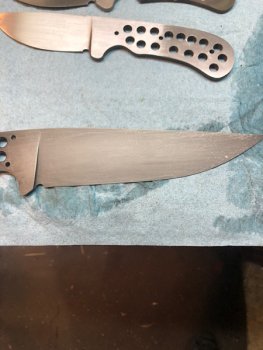You are using an out of date browser. It may not display this or other websites correctly.
You should upgrade or use an alternative browser.
You should upgrade or use an alternative browser.
Well This Is Weird
- Thread starter Randy Lucius
- Start date
tkroenlein
Well-Known Member
Looks good to me!
Randy Lucius
Well-Known Member
Thanks for all the help guys. It’s greatly appreciated!!
Randy Lucius
Well-Known Member
Hi John. Not really sure about the spots. Think I just gonna finish it and keep it around the shop. I think my problems were a little too much heat and a little too much soak. The next one I’m thinking I’ll take to 1425 without any soak time. What do you think?What is causing the white spots at the tip and back near the plunge line?
Its either decarb or some cleaner or something left on the blade.
J. Doyle
Dealer - Purveyor
Hi John. Not really sure about the spots. Think I just gonna finish it and keep it around the shop. I think my problems were a little too much heat and a little too much soak. The next one I’m thinking I’ll take to 1425 without any soak time. What do you think?
Not a hard and fast rule but more of a general guideline.....if there's a varying range in a steel's austenitizing temps and a varying range of soak times, you could approach it like this:
If you use the higher end of the austenitizing temp range you could decrease the soak time. Conversely, you could choose the lower end of the austenitizing range and increase the soak time.
So according to that generalization, going on the low end of the temp range with zero soak *might* not be adequate for full solution and full hardening. (If everything went perfect and your temps were accurate and the blade was fully up to temp internally, you'd *probably* be okay with 1084).
Were it me and using 1084, I'd probably personally shoot for 1450 and soak for not more than 5 minutes. That would be hot enough, but gives you a pretty good cushion against overheating. The short soak makes sure everything has time to reach full solution but won't do any harm at that temp.
Randy Lucius
Well-Known Member
Thanks John. That makes a lot of sense.Not a hard and fast rule but more of a general guideline.....if there's a varying range in a steel's austenitizing temps and a varying range of soak times, you could approach it like this:
If you use the higher end of the austenitizing temp range you could decrease the soak time. Conversely, you could choose the lower end of the austenitizing range and increase the soak time.
So according to that generalization, going on the low end of the temp range with zero soak *might* not be adequate for full solution and full hardening. (If everything went perfect and your temps were accurate and the blade was fully up to temp internally, you'd *probably* be okay with 1084).
Were it me and using 1084, I'd probably personally shoot for 1450 and soak for not more than 5 minutes. That would be hot enough, but gives you a pretty good cushion against overheating. The short soak makes sure everything has time to reach full solution but won't do any harm at that temp.
Mark Knapp
Dealer - Purveyor
I get light grey flecks under the black quite often, to me it looks perfect. That's when I know I've done everything right. But I never soak for fifteen minutes. That's a recommendation for steel parts in general (I suspect) not for thin knife blades. We only soak that long or longer to get good welds in powder metal damascus.

